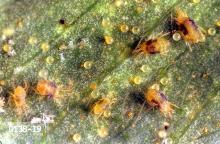Tetranychus urticae
Pest description and crop damage Adults are about 2-3 mm long, have eight legs, and are light tan or greenish with a dark spot on each side of the back. Mite feeding reduces plant vigor and may cause leaves to curl, turn brown, and drop prematurely reducing yield. Spider mite feeding is accompanied by webbing on the undersides of the leaves.
Biology and life history Adults overwinter around buds or in plant debris, not only on strawberries but also on a wide range of plants. Warm temperatures significantly increase spider mite activity, and the entire life cycle may be completed in as little as 5 to 7 days under warm summer conditions. Therefore, there are many overlapping generations per year. Mites do not fly but are blown from plant to plant or are carried on plant material or equipment. On individual plants, they can walk from infested to new parts of the plant.
Scouting and thresholds Inspect oldest leaves first for stippling; webbing and the mites themselves can be found on the underside of leaves. Infestations early in the year, April or May, cause the most injury. If the population reaches an average of 20 to 25 mites per leaf, treatment is advisable. If the population remains low and does not rise until near or after harvest, treatment is probably not necessary.
Management-biological control
Rain and cool temperatures tend to suppress mite populations. Considerable natural control is provided by lady beetles and minute pirate bugs (Orius spp.). Predatory mites such as Typhlodromus spp. or Neoseiulus fallacis (syn. Amblyseius fallacis) are also effective at managing populations of spider mites and may be purchased and released. Use according to supplier's directions.
Management-cultural control
Excessive nitrogen fertilization may cause population buildup. Avoid early season applications of insecticides, which reduce populations of beneficial insects. Spider mite infestations are favored by dry, dusty conditions, so avoid creating these situations and stressing the plants.
Home gardeners: Mites can be hosed from plants with a strong stream of water.
Management-chemical control: HOME USE
- azadiractin-Some formulations are OMRI-listed for organic use.
- horticultural oils
- plant essential oils (peppermint, rosemary, thyme) and cottonseed and garlic oils-Some formulations are OMRI-listed for organic use.
- sulfur
Management-chemical control: COMMERCIAL USE
- abamectin (Agri-Mek, Timectin and other brands) at 0.019 lb ai/A. PHI 3 days. Make two applications 7 to 10 days apart when mites first appear. Repeat this sequence of applications, if necessary, to maintain control (wait at least 21 days). Do not exceed 0.075 lb ai/A in one growing season. Do not use less than 100 gal water/A.
- acequinocyl (Kanemite) at 0.2 to 0.3 lb ai/A. PHI 1 day. Controls all stages of mites.
- azadiractin (Ecozin Plus and other brands)-Consult label for rate and use directions. Some formulations are OMRI-listed for organic use.
- Beauveria bassiana (Mycotrol and others)-Consult label for rate. PHI 0 days. Potentially pathogenic to bees. Time applications accordingly.
- bifenazate (Acramite) at 0.375 to 0.5 lb ai/A. PHI 1 day. Make two applications at least 21 days apart. Do not exceed two applications per season. Controls all motile stages, not eggs.
- bifenthrin (Brigade and others) at 0.1 to 0.2 lb ai/A. PHI 0 days. Hazardous to bees. Restricted use pesticide.
- cyflumetofen (Nealta) at 0.17 lb ai/A. PHI 1 day. Do not make sequential applications. Controls all stages of mites. Good coverage is essential for effective mite control.
- Burkholderia spp. (Venerate XC)-Consult label for rate. PHI 0 days. OMRI-listed for organic use.
- Chromobacterium subtsugae (Grandevo)-Consult label for rate. PHI 0 days. Temporarily repels bees; time applications accordingly.
- diazinon (several brands) at 0.5 lb ai/A. PHI 5 days. Hazardous to bees. Restricted use pesticide.
- etoxazole (Zeal) at 0.09 to 0.135 lb ai/A. PHI 1 day. Do not apply more than twice per crop season. Controls eggs and young mites only.
- fenbutatin-oxide (Vendex) at 0.75 to 1 lb ai/A. PHI 1 day. Apply in 150 to 200 gal/A. Apply when mites appear. Do not apply more than twice per year. Good coverage is essential for effective mite control. Adjust spray volume and nozzle placement to ensure coverage of top and underside of leaves.
- fenpyroximate (Fujimite) at 0.1 lb ai/A. PHI 1 day. Most active on mite nymphs. Do not exceed 0.2 lb ai/A per season.
- hexythiazox (Savey) at 0.19 lb ai/A. PHI 3 days. Controls eggs and young mites only; does not control adult mites. Do not apply more than once per crop season.
- insecticidal soap (M-Pede and other brands)-Consult label for rate. PHI 0 days. Some formulations OMRI-listed for organic use.
- naled (Dibrom) at 0.94 lb ai/A. PHI 1 day. Hazardous to bees. Restricted use pesticide.
- propargite (Mitomax and others) at 1.5 lb ai/A. Non-bearing only. Restricted use pesticide.
- pyridaben (Nexter) at 0.22 to 0.5 lb ai/A. PHI 1 day for dry formulation; 10 days for liquid formulation. Do not exceed 0.75 lb ai/A per crop season.
- spiromesifen (Oberon 2SC) at 0.25 lb ai/A. One application per year. PHI 3 days. Controls eggs and young mites only.


